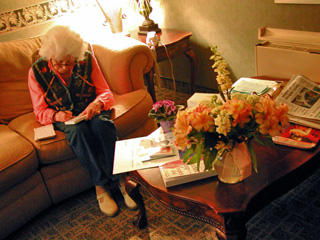Human Flower Project
Just What the Doctor Should Order
Appendectomy? Two horticulture researchers document how flowers and foliage can hasten your recovery.
 White cyclamen and cards at a hospital patient’s bedside, Louisville, Kentucky
White cyclamen and cards at a hospital patient’s bedside, Louisville, Kentucky
Photo: Human Flower Project
“Get me outta here!” – the battle cry of hospital patients around the world.
Seong-Hyun Park and Richard Mattson, horticulturists at Kansas State University, have a new paper out that sheds light—and relief—on this ancient predicament. They found that having flowering and foliage plants in the room significantly improved patients’ comfort, health, and attitudes while recovering from surgery.
The researchers studied 90 patients who had appendectomies—a fairly routine surgical procedure—in a suburban Korean hospital. In half the patients’ rooms, the researchers placed twelve plants:
dendrobium orchids (Dendrobium phalaenopsis)
peace lily (Spathiphyllum “Starlight’)
golden pothos (Epipremnum aureum)
kentia palm (Howea forsteriana)
arrowhead vine (Syngonium podophyllum ‘Albolineatum’)
cretan brake fern (Pteris cretica ‘Albolineata’)
variegated vinca (Vinca minor ‘Illumination’)
yellow star jasmine (Trachelospermum asiaticum ‘Ougonnishiki’)
“Single plants of four species were arranged with two plants each of dendrobium, peace lily, golden pothos, and kentia palm.” In other words, we’re talking not just one African violet but small nursery!

Comparing the effects of two hospital rooms: A. Plantless B. Plantful
Photo: Courtesy of Seong-Hyun Park
The patients’ length of stay did not differ much (the plant group on average was released from the hospital about a half a day sooner than the non-plant patients). But the researchers did find many significant differences.
By the third day post-op, the plant-recipient group had less need for pain killing drugs. They had lower systolic blood pressure by the day after their appendectomies and reported significantly less fatigue and anxiety than the plantless patients.
“Plants were associated with positive memories, and some patients believed that plants had diminished their pain,” the scholars report. We found especially interesting that with lilies and jasmine at hand, the patients soon began taking an active interest – a not-so-small step in returning to healthy, everyday life. “As patients recovered from surgery and regained mobility, “ write Park and Mattson, “nursing and medical staff reported increased interaction with plants. This included watering plants, removing dead leaves, touching them and moving them for a better view or close to a window for better sunlight.”
From helpless “sick people,” these patients were coaxed to becoming caretakers.
 At a patient’s bedside, loving wife, newspapers and flowers
At a patient’s bedside, loving wife, newspapers and flowers
Photo: Human Flower Project
Park and Mattson found that the presence of flowers and plants also significantly improved patients’ views of the hospital itself and the care they had received. (Legal departments, take note!)
As they follow up these findings, we hope the scholars will pursue some cross-cultural research. Could it be that Koreans are more attuned to plants and flowers than, say, Canadians or Moroccans, and thus can receive more healthful benefits from having flowers and foliage close by?
Many thanks to Seong-Hyun Park for sharing this fascinating research. The complete article was published in Hort Tech 18: 549-745 (2008).


Well established in the field of environmental design and environmental psychology. Read Rachel Kaplan, PhD (http://www.snre.umich.edu/profile/rkaplan); Robert Ulrich, PhD; and Clare Cooper Marcus (http://www.amazon.com/Healing-Gardens-Therapeutic-Recommendations-Healthcare/dp/0471192031). Also, see the Therapeutic Landscapes Database blog at http://tldb.blogspot.com/